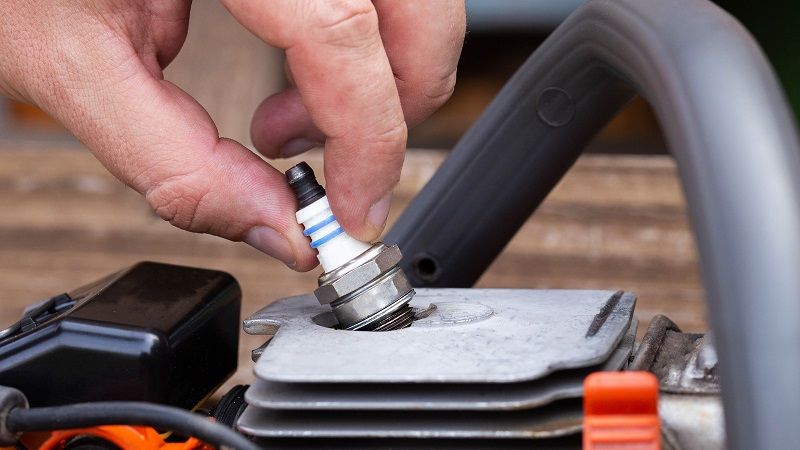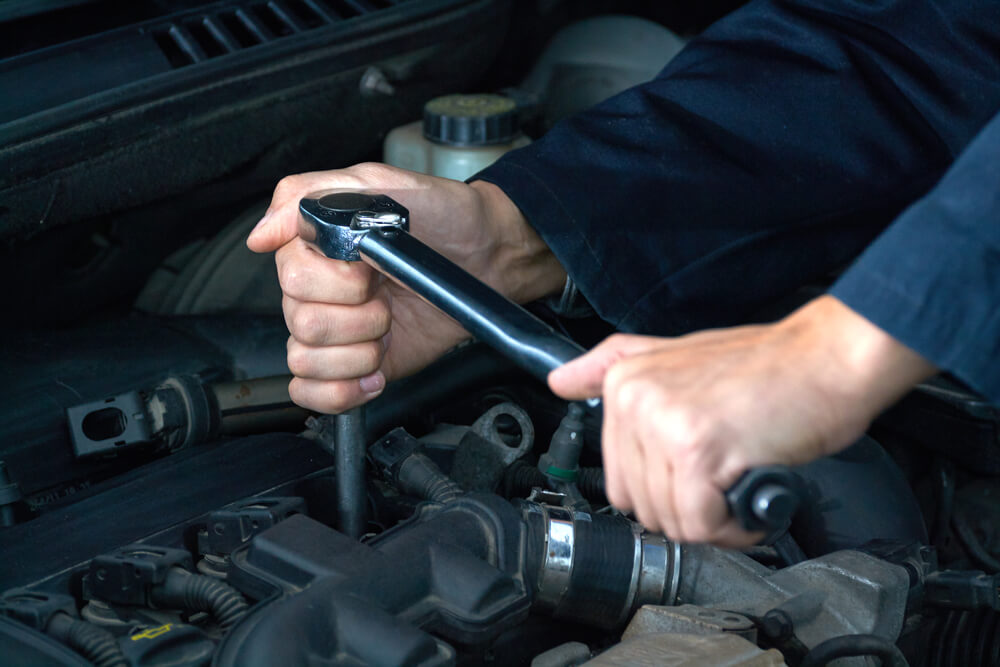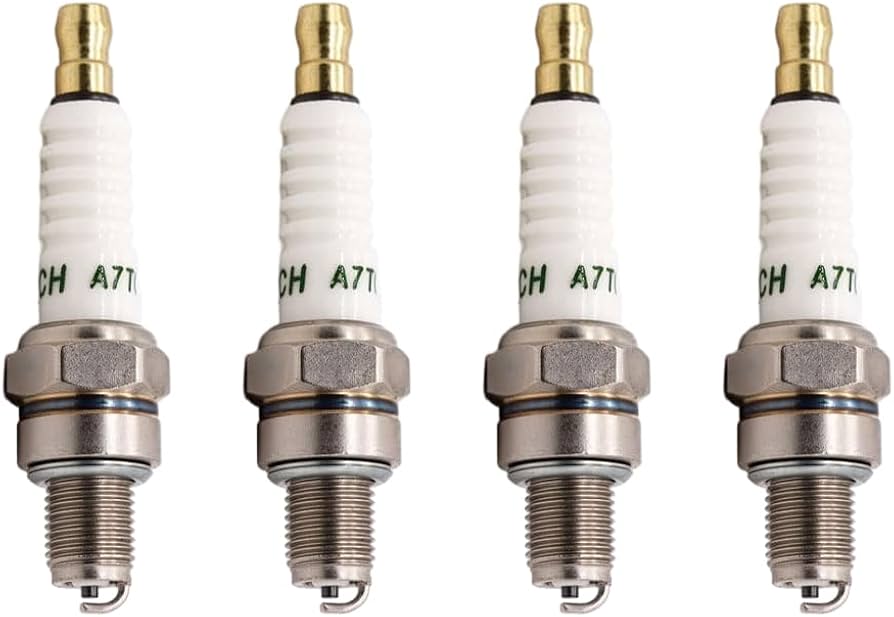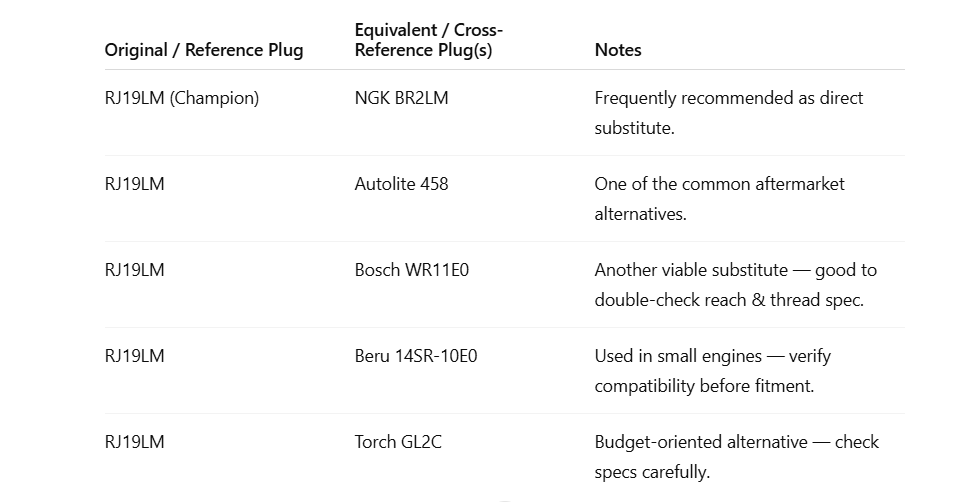How to loosen a stuck spark plug involves applying penetrating oil, letting it sit, and then using a spark plug socket with a ratchet wrench. If it’s still stuck, use a breaker bar or apply heat for better leverage.
Spark plugs are the little heroes that keep your car’s engine running by triggering the mini-explosions that power the pistons. Unfortunately, heat, moisture, and grime love to eat away at them. After a few hundred starts, a simple twist can feel more like a battle. No need to freak out over a seized plug—you can set it free without torching your engine or your mood.
This laid-back, step-by-step guide walks you through it. First, we’ll explain why plugs rust in the first place. Next, we’ll list the tools you can probably grab right from your own driveway. We’ll then show you simple kitchen or garage recipes for preventing the next seize, and we’ll tackle the nagging “why me?” questions you’ll probably have once that first plug laughs at your wrench.
No fancy experience required—whether you’re picking up a wrench for the first time or you grease your hands for lunch, you’ll find the info you need.

Contents
- 1 Why Do Plugs Lock Up? Here’s Your Quick Checklist
- 1.1 Tools to Pull a Stuck Spark Plug
- 1.2 How to Loosen a Stuck Spark Plug
- 1.2.1 Step 1: Wait for the Engine to Cool
- 1.2.2 Step 2: Clear the Workspace
- 1.2.3 Step 3: Soak the Stubborn Plug
- 1.2.4 Step 4: Use the Socket and Ratchet
- 1.2.5 Step 5: Breaker Bar to the Rescue for Cranky Plugs
- 1.2.6 Step 6: Add Some Heat
- 1.2.7 Step 7: Wiggle to Break Loose
- 1.2.8 Step 8: Remove the Plug
- 1.2.9 Stop Spark Plugs from Marrying the Engine
- 1.3 Frequently Asked Questions
- 1.4 Conclusion
Why Do Plugs Lock Up? Here’s Your Quick Checklist
Before you grab the ratchet, take a snapshot of why spark plugs seize. Erase those chalky, stuck goblins today, and your wrists and the socket bay will sing thank you the next oil change. Usual suspects: a chewed-up spark plug wire, damp-weather electrolysis, scorching head, or a DIYer who went rogue on the torque spec. Nail the why behind the imprisonment this round, and you’ll stroll past this drama all the months ahead.
1. Corrosion
Water, road-muck, and exhaust fumes sneak in around the spark plug and the cylinder head, and before you know it, rust forms. Once corrosion sets in, the plug almost gets “glued” to the head by rust tracks. When you try to twist it out a month later, it feels like a locked bolt from a 20-year-old project. Cars that frequently sit in the rain, work under dirt clouds, or roll around with the same set of spark plugs well past their life are the typical victims.
How it affects removal:
The rust bond resists the gentle turn every mechanic expects. As you crank, the spark plug slides a millimeter, and the head itself starts to act like a big, seized nut. Instead of lifting, the metal twists. If you keep heaving, the connector center shears off, and the metal shell stays inside the head, ready to demand a rescue.
2. Over-tightening
Each plug has a torque spec that keeps it in that Goldilocks zone of snug: tight enough to seal, loose enough to leave later. When you ignore that chart, the metal starts to moan under the extra twist. You can mess up the female threads in the head or, worse, flatten the threads on the plug. Now your “escape plug” seems cemented there like a trophy mounted the hard way.
How it affects removal:
Too much plastic wrench tortures the fine helix inside the cylinder head. Instead of gently releasing, the spark plug screams bravely and yet stays statue-like, refusing even PB Blaster rescue on the next attempt.
Where you expect a tidy spiral track for the spark plug to slide in and out, the opening ends up looking more like a jagged cage. The plug tries to rotate, but the threads seize up as if glued in a rusty vise, and all the torque in the world can’t break it free.
If you force the engine to build more pressure in this stuck condition, you’re one foul rev away from cracking the plug insulator or doing serious damage to the cylinder head. The metal’s on the edge already; all it needs is the wrong swell of heat and friction to cave in.
3. Heat Cycling
Every time you crank the engine, the spark plug and cylinder head heat up, stretch, and grow. When you shut off the engine, they cool down, shrink, and return to the original size. Do this 10,000 times, and the plug seats itself tighter with each cycle.
How it slows removal: This constant expansion and contraction pushes the plug deeper into the head until it locks up like a vise. By the time you reach for the socket, any leftover grease in the threads has turned to gritty paste, making the plug feel like a piece of the head itself.
4. No Anti-Seize
Old-school techs never skip the anti-seize on the plug threads. That little dab prevents bare metal from grinding and chafing, plus it keeps high cylinder-head temps from welding the plug in. Forget it, and the two dry, bare surfaces bite down harder, adding to the resistance you already have.
How it slows removal: Without the anti-seize, the threads corrode. In the worst cases, they actually bond. Many times after the original tech has packed up for the night, a fresh mechanic pulls the handle, and instead of the plug, the cylinder head breaks loose and turns with the ratchet.
Sure, coat the threads with anti-seize before you start, and the spark plug drops out like it’s greased, not like you’re fighting it with a mallet and a flathead.
Tools to Pull a Stuck Spark Plug
If a spark plug’s wedged in there, you want to pull it with care or you’ll start shopping for a replacement head and those don’t come cheap. Don’t take shortcuts, don’t wing it, and definitely don’t grab whatever’s lying around the bench. Snag the gear listed here to yank it free, keep the engine safe, and keep the repair bill breezy.
1. Spark Plug Socket
Think of the spark plug socket as your secret weapon. It’s the only socket shaped to hug the spark plug and yank it out without injury. Don’t buy a cheap one without the rubber or foam insert, because without it, the ceramic that looks like a tiny coffee cup gets cracked. Grab one mini socket that’s the right size before you even start to crack a bolt and you’re already ahead of the game.
Why it’s important: The rubber insert squeezes the plug as you turn it, spreading the force evenly so it won’t twist free. That gentle hug works wonders, slashing the chance of the plug snapping off in the cylinder head. It’s a simple detail, but replacing a full plug is a walk in the park compared to digging out a broken chunk.
2. Ratchet Wrench
The ratchet wrench does the muscle work when it’s time to turn the spark plug socket. Go with one that feels sturdy—it needs to take a little extra twist when the plug is stubborn. A 3/8-inch drive ratchet is the sweet spot for most cars. It’s compact enough to fit in tight spots but still strong enough to muscle out a crusty plug.
3. Penetrating Oil
Grab a handy penetrating oil spray such as PB Blaster or Liquid Wrench, or even the trusty WD-40. This oily mist slides into the gaps around the spark plug, gently loosening the rust bond formed over the years.
Why it matters: Skipping this step means you’re fighting decades of corrosion, and a simple spark plug swap can turn into a garage-scale wrestling match. A single squirt gives the oil time to penetrate and carry away the rust, so the plug can twist free without the fragile ceramic shattering.
4. Breaker Bar
Imagine a ratchet handle stretched like a superhero—no fancy gizmo here, just solid length that multiplies the force you put in. Slip a spark plug socket over the end, and you get the ultimate pry without raising a sweat.
Why it matters: That extra stretch turns stubborn plugs into easy targets, saving the socket and your knuckles from the bit of steel that usually gives up. When your little ratchet runs out of muscle, the breaker bar shows up, applying smooth, unwavering force until the rust finally breaks free.
5. Heat Gun or Propane Torch
When it seems like the spark plug is bonded like it came out of the factory that way, sending in some heat creates a small miracle. A heat gun or a compact propane torch lets you warm up the metal around the plug without frying the whole engine. The heated metal grows, shrinks the rust, and gives the hardened plug a bath it used to enjoy in the old days.
Why it matters: Metal that’s warmer lets go of stubborn bonds, so the plug unscrews without the extra muscles that can snap the collar off the plug. Just wave the heat source up and down, or side to side, so you don’t toast the cylinder head or the wires waiting nearby. Those parts like the routine chill, and kindness beats a rash bolt every time.
6. Torque Wrench
Once you get the hard-worn plug out and replace it with a shiny new one, the torque wrench steps in. This tool brings the plug into the sweet spot of snug without fighting dirty, securing a proper seal so heat, pressure, and daily drive can treated it like a valued guest.
Why it matters: A whirlwind coup for the over, the plug might strut out the way it came in or throw hot sparks. Over-tight, it might grin too hard and fuse into tomorrow’s oil-most headcases. The torque wrench delivers the exact number the service sheet made chocolate syrup kinds you expect in realistic reads, keeping hardaired spark plugs in the sweet-warm snug that’s just more the neighborhood.
7. Safety Gear
Before you pop that hood, make slipping on some safety gear the first thing you do. Lightweight gloves keep your hands comfy while the spark plugs are hot, goggles protect your eyes from flying debris, and a simple face shield can guard you against metal chips or a splash of boiling coolant that always seems to jump. Takes just a few seconds to put ‘em on, but the pain you’ll avoid makes these seconds the most important of your session.
How to Loosen a Stuck Spark Plug
Getting a stuck spark plug to move without damaging the engine requires both patience and the right steps. Follow this simple guide to break the bond without breaking anything.
Step 1: Wait for the Engine to Cool
Time for the waiting game. Shut off the engine and let it cool for 30 minutes to an hour, keeping your hands off that spark plug until it’s safe. Hot metal can burn your skin and weaken the plug to the point of breaking.
Tip: Use that waiting time to grab a snack or sip on something cold. Great way to keep your energy up, and it’s the perfect excuse to spot any other simple fixes you might want to tackle while you’re already on the scene.
Step 2: Clear the Workspace
Nothing ruins a simple task like a little dirt falling into the cylinder. Grab a can of compressed air or a soft-bristled brush and clear any debris that’s hanging around the plug.
Tip: Angle the brush or air can sideways, blowing or brushing dirt away from the plug hole, not into it. That tiny effort now stops a bigger mess from playing hide and seek in your engine later on.
Step 3: Soak the Stubborn Plug
Coat the neck of the spark plug in penetrating oil—don’t be shy, cover it well. For plugs that are really crusted, leave it alone for 15 to 30 minutes, or overnight if the plug feels stubborn.
Quick Tip: While the oil is working, use the time to organize your small tools. A 30-second tidy can stop your tiniest wrench from turning into an expensive mystery later.
Extra Tip: Don’t be stingy—let extra oil pool in the recess. That extra inch will sneak down the threads and help loosen stubborn rust or corrosion.
Step 4: Use the Socket and Ratchet
Slip the spark plug socket over the plug and lock it to the ratchet. Press it down straight, then twist to the left slowly. Gentle, consistent pressure is the key. You want to massage that plug free, not wrench it to pieces.
Quick Tip: If the plug won’t budge, stay calm. Keep applying the same steady pressure; a gentle coax is often the final nudge the bolt needs to free itself. Don’t rush.
Sometimes a tiny rust puppy needs a smidge more coaxing, and a yank can yank the tiny electrode off like a loose tooth. Don’t let that happen!
Step 5: Breaker Bar to the Rescue for Cranky Plugs
Adapter still giggling in your face? Day to bring in the muscle: the trusty breaker bar. Slip the breaker bar onto your trusty ¼-inch socket. That length turns stubborn into surrender with a quick, gentle nudge.
Pro tip: move in easy loops, not karate chops—ceramic doesn’t like head trauma. If it’s still stuck, take a beat, let the penetrating oil have a tiny spa break, and repeat the gentle lift. Small victories stacked on small victories beat the nasty regrets of big, angry snaps.
Step 6: Add Some Heat
If the spark plug still won’t move, warming the area around it can help. Use a heat gun or a propane torch, but never heat the plug itself — heat the metal around it. This lets the surrounding metal expand and can loosen the rust or carbon in the threads.
Pro Tip: Use the lowest heat you can. A small soft flame or low setting is best. Let it run for 1–2 minutes, then test the plug again. You want heat, not warping.
Step 7: Wiggle to Break Loose
Instead of just cranking on it, try a twist to the right, then back to the left. This tap back-and-forth helps shatter the rust seal without destroying the plug.
Quick Method: Turn it a quarter right, a quarter left, and repeat that 3–5 times. If it still won’t budge, heat it again, then repeat the wiggle.
Step 8: Remove the Plug
Once the spark plug moves even a little, grasp the ceramic part gently. Keep a smooth, steady twist in the same direction it loosened, and it should come free without breaking.
Avoid forcing anything, as that could lead to bigger headaches. Start by inspecting the spark plug and the threads in the cylinder head to catch any clear issues.
What to Examine: Look at the spark plug for any cracks or worn-down electrodes. Then, turn to the threads in the cylinder. They need to be clean and smooth. If they’re stripped or rough, a thread repair kit or a professional might be your next step.
Tip: Keep the old spark plug handy in the garage while you’re sliding in the shiny new one. A quick glance at the old plug shows if the bling-bling ad really worked, or if the car still needs more TLC.
Stop Spark Plugs from Marrying the Engine
You don’t want to yank one out and find powdery ceramic sitting all over. Use the plug you’re replacing as a makeshift tool by following these easy tricks.
Slick on Some Anti-Seize: Just one thin smear of anti-seize on the threads costs a couple of dimes but saves you a world of headaches later. The grease prevents the plug and the cylinder head from sticking tighter than old chewing gum. Next removal day, you’ll pop that plug out with a smile—not a swear.
Torque Is Your Best Buddy: Wailing on that plug with a ratchet like it’s the last lap at Watkins Glen is a rookie move. Grab the torque wrench, set it to the setting in the owner’s manual, and listen for that sweet “beep.” That sound is your victory lap—gold star awarded.
Under the Hood, Peek and Polish: Lift the spark plug boots every few months. Dust and grit like to sneak in and steal the spark’s shine. A quick peek keeps the flame burning bright and the car ready for that daily commute without a hiccup.
Scrub that grit, grab your caliper or feeler gauge, and believe whatever number the caliper gives you. A plug that’s totally flat, has light scratches, or looks like a crusty penny? That’s a goner by the next oil change. Leave baked-on carbon or old oil sludge under the hood for just a couple winters, and it hardens into a tile of carbon glass, cementing the plug like a cocktail of concrete and expired gasket material.
Frequently Asked Questions
Here are some FAQs about loosening stuck spark plug –
1. What if the spark plug breaks and leaves part in the head?
Breathe. Snag the loose outer shell with a magnet, or tease it out using needle-nose pliers. If the center bit is still there, a screw extractor is your next move. If that stalls, it’s time for the pros—they already have the gadgets. Now the mess is on them, not you, and your garage gets the Saturday parking space you promised it.
2. Can I just spray a spark plug with WD-40 and go on my way?
Sorry, that won’t cut it. WD-40 is the go-to for a squeaky door or a stubborn lawnmower switch. For a spark plug, a penetrating oil like PB Blaster or Liquid Wrench is the true first responder. It creeps into rust, softens the grip, and gives you a fighting chance of loosening the plug without celebrating a win that ends with a shattered porcelain and the smell of burnt ozone.
3. How do I check if the spark plug threads are ruined?
Inspect the spark plug threads and the threads in the cylinder head. Search for rust, bent edges, or if the threads no longer match up. If anything is out of whack, a thread chaser might help, but a seasoned mechanic can usually do the fix faster and cleaner.
4. Is It Safe To Use Heat On A Stuck Spark Plug?
Heat can help free a stuck spark plug, but you have to be smart about it. Too much heat can damage the head, the coil, and your wallet, so don’t blast the plug itself. Instead, warm the area around the spark plug— the head— using a heat gun or a gentle propane torch. A torch is faster but can also start a fire, so safety first. No matter which you use, don’t grab the plug right away; it can burn you for a minute or longer.
5. How Often Should I Change Spark Plugs?
Spark plug replacement usually happens between 30,000 and 100,000 miles, but it really depends on the type you have and the owner’s manual. Skipping the swap can drop your fuel economy and make the engine sluggish. So, check the manual and set a reminder.
Conclusion
A capped spark plug can be a nuisance, but it doesn’t get to win. With a few simple tools, a patient hand, and a solid plan, you can free it without scarring the cylinder head. Heat to the head, let penetrant do its job, and never skip anti-seize on the new plugs. When you get to the next tune-up, the job is faster, and the total bill is often smaller.
Work carefully, and you’ll complete the job the right way— on your schedule and your terms.
Wishing you smooth turns and tight bolts! Enjoy the ride while you tune it up!





